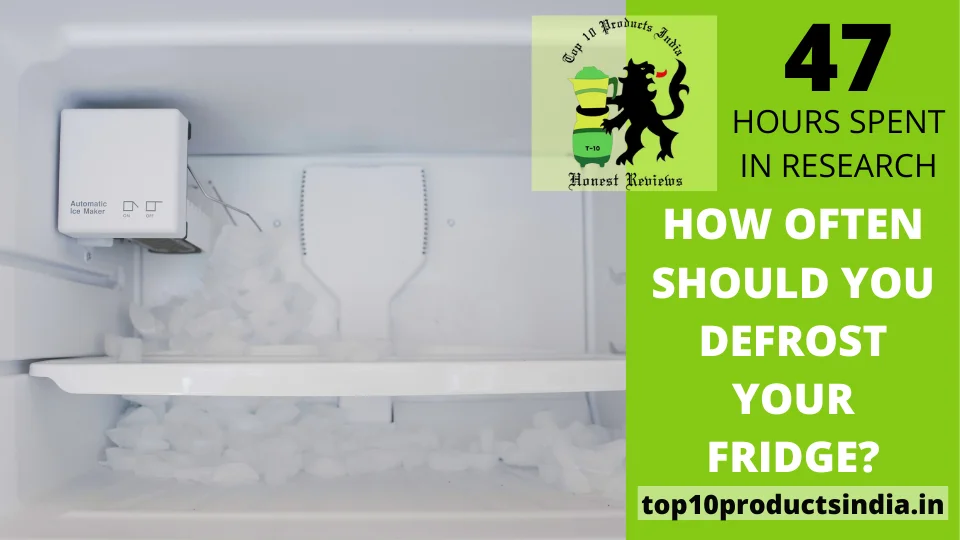The defrost feature in refrigerators helps ensure that our food is fresh and drinks cool; however, it must be maintained regularly to ensure it functions effectively. One of the most important tasks in maintaining the refrigerator is defrosting. Defrosting involves getting rid of the buildup of ice in the freezer as well as other components of the fridge.
In this blog, we’ll talk about the frequency you need to remove the frozen portion of your fridge as well as the indications that it’s time to defrost and the steps to defrost it if you follow these steps to ensure that your refrigerator is running at a high level and prolong its life.
Why is it vital to defrost your fridge frequently?
The buildup of ice can affect the effectiveness of your fridge. Ice buildup in the freezer and other fridge components may block airflow, causing the fridge to work harder to keep the ideal temperature. This could result in increased consumption of energy and more expensive electricity costs.
The buildup of ice can cause damage to the refrigerator. When ice builds up, it puts pressure on the components and walls of the fridge, which can cause them to break or crack. This can result in costly repairs or even the replacement of the refrigerator completely.
Defrosting your refrigerator can help ensure your food stays fresh and clean. If ice accumulates in the refrigerator, it could create an ideal environment for the growth of bacteria that can infect your food items and make them dangerous to eat. If you regularly defrost your fridge to ensure it’s clear of harmful bacteria.
In the end, defrosting your refrigerator frequently is vital to ensure its effectiveness, avoid damage, and guarantee the freshness and safety of your food items.
How to prevent the build-up of frost in refrigerators
To comprehend why defrosting your refrigerator is essential, it’s important to understand how to frost build-up is a problem in refrigerators.
As you walk through the refrigerator doors, humid air from the room is brought into the refrigerator, and it comes into contact with cold surfaces. The moisture from the air expands and then freezes on the surfaces, forming a frost layer. As time passes, the layer of frost will become dense and more difficult to remove, negatively impacting the efficiency and effectiveness of your refrigerator.
In addition, if the frost layer gets excessively thick, it may hinder the functioning of the cooling system, which can result in a lower life span for your appliance. It is important to clean your refrigerator regularly to stop frost buildup from becoming out of control.
Benefits of regularly defrosting your refrigerator
- Increased Efficiency in Energy Use: If a layer of frost is in your fridge, it needs to be more efficient in keeping the temperature down. This means it consumes much more power, and this could raise your electric bill. Defrosting your refrigerator regularly can help remove the layer of frost and make your appliance run more efficiently.
- Improved Food Preservation: Excessive frost in your refrigerator could cause problems with circulating cold air. It can also prevent foods from cooling properly. This could cause food to go through more quickly. Regularly defrosting your refrigerator ensures that your food is stored at the correct temperature and is fresher for longer.
- Extended Lifespan of Appliances: If the buildup of frost gets excessive, it could strain your refrigerator’s cooling system and cause premature wear and tear. Regularly defrosting your refrigerator will prevent the accumulation of snow accumulation and make sure your appliance lasts longer.
- Improved air quality: If there are a lot of frosts inside your refrigerator, it will produce a musty smell and encourage the growth of mould and bacteria. When you regularly defrost your refrigerator to keep the interior air fresh and fresh.
In the end, defrosting your refrigerator regularly can save electricity costs, prolong the appliance’s life, and keep your food safe and fresh to consume.
The signs that your refrigerator needs defrosting
- Frost build-up: One of the most obvious indicators that your refrigerator needs defrosting is ice on the shelves, walls and drawers. If you see an accumulation of ice or frost of more than 1/4 inch, it’s time to defrost your refrigerator.
- Reduced cooling performance: Another indication that your refrigerator needs defrosting is if you observe that your cooling performance has decreased. This could be due to a high level of frost if it is struggling to keep the temperature or if food isn’t as cold as it is supposed to be.
- Strange Noises: If you notice unusual sounds coming into your fridge, like grumbling or humming, It could be a sign that the buildup of frost is causing your cooling system to be more efficient.
- Leakage of water: If you observe water accumulating on the floor in front of the refrigerator or spilling out of the walls inside, It could be caused by excessive frost build-up. The ice may melt and lead to water leakage from the walls.
- Increased Energy Costs: If you have noticed your energy costs have gone up for no apparent reason; it could be due to an excessive accumulation of frost in your refrigerator. The additional work needed to maintain temperature could cause your refrigerator to consume more energy, increasing electricity costs.
If you observe any of these symptoms, It’s a good idea to get your refrigerator defrosted as quickly as possible to prevent harm and ensure your appliance is functioning efficiently.
How often should you defrost your fridge?
Factors that influence the frequency at which you need to defrost your refrigerator
- Frequency of Utilization: The more frequently you shut and open your refrigerator’s door, the more warm, humid air is introduced into the fridge, which leads to an increase in frost accumulation. If you are using your refrigerator often, you might need to defrost it often.
- Humidity: The humidity level within your home may influence the frequency at which you will need to remove frozen food from your refrigerator. If you reside in an area that is humid and there is increased humidity in the air can cause more frost to build up.
- Size of the freezer: Your freezer’s size will affect the frequency at which you must open your refrigerator. In the case of a small fridge, it will be filled faster, and the building of frost will be much faster.
- The type of food that is stored: Foods that are stored in certain categories, like vegetables and fruits, release moisture when they get old, leading to the build-up of frost inside your refrigerator.
Different refrigerator models and the requirements for defrosting
- Manual-Defrost Refrigerators: They require manual defrosting, usually each 6-12 months. It is necessary to shut the fridge off, remove the contents from the freezer, and let the frost melt naturally.
- Automatic-Defrost Refrigerators: A defrost function melts the frost regularly, generally between 8 and 12 hours. There is no need to unfreeze these refrigerators manually; however, checking them regularly is recommended to ensure that the dissolution process operates properly.
- Frost-free refrigerators do not require manual defrosting since they feature an element of heating that melts the frost in a controlled manner. But, they require periodic cleaning to avoid excess accumulation of frost.
Expert’s Word
The frequency at which you need to defrost your refrigerator is contingent on various factors, including the kind of refrigerator you own and the environment in which you live. It’s recommended to regularly check your refrigerator for any signs of frost build-up and follow the manufacturer’s recommendations regarding defrosting.
Step-by-step instructions on how to defrost your refrigerator.
Step 1: Switch off the refrigerator first. Disconnect your refrigerator, or turn off the circuit breaker.
Step 2: Dispose of the contents: Transfer everything in the freezer and refrigerator to an additional refrigerator or cooler to keep them chilled.
Step 3: Remove removable parts: Remove any accessible shelves, drawers, or trays from the refrigerator and freezer compartments. This will enable you to get them cleaned more thoroughly in the future.
Step 4: Allow the Frost to melt. Open your refrigerator and freezer doors and let the frost melt naturally. Set a tray or towel beneath the freezer to collect any water that melts.
Step 5: Speed up the process Step 5 Speed up the Process: If you wish to accelerate the process, put hot water bowls inside the refrigerator or freezer compartments. This will allow you to melt the frost faster.
Step 6: Cleaning the Interior When the frost is gone and sunk into the ground, you can use mild and hot water. This will scrub the inside of the freezer and refrigerator compartments. Make sure you clean all open shelves or drawers and tray thoroughly.
Step 7: Dry the interior. Clean the inside of the freezer and refrigerator compartments using a dry wet towel or cloth to remove any moisture.
Step 8: Replace the Removable Parts. When the inside is dry, you can replace the shelves, drawers and tray.
Step 9: Plug the refrigerator Plug into your refrigerator or switch it back on by turning the circuit breaker. Allow the refrigerator to cool before returning the food items to the compartments.
Following these steps makes it possible to defrost your refrigerator efficiently and ensure it runs smoothly. It’s recommended to periodically defrost your refrigerator to prevent excessive frost build-up and ensure maximum performance.
Tips for maintaining your refrigerator’s performance after defrosting
- Maintain the cleanliness of your refrigerator. Keep the interior clean of your freezer and refrigerator to avoid dust and other debris accumulation. This can help stop the development of mould and bacteria, which can negatively impact the performance of your refrigerator.
- Examine the Door Seals. Make sure your door seals remain in good condition and free of obstructions. Door seals that are damaged or dirty can lead to air leaks and affect the temperature of your refrigerator.
- Let food cool before Storage Food that is hot should be allowed to cool down to room temperature before storing it in a refrigerator. This will stop the temperature in the refrigerator from rising, which could affect the appliance’s performance.
- Maintain the proper temperature. Set the temperatures of both your freezer and refrigerator at the recommended levels, generally between 5 and 0 degrees Celsius in the fridge and between -18 and 15 degrees Celsius in the freezer.
- Avoid overloading the refrigerator. It could affect the appliance’s performance, restricting airflow and stopping the refrigerator from maintaining an optimal temperature.
- Don’t block air vents. Check that food items or other objects don’t block the vents for air inside the freezer and refrigerator. Vents’ blockage could affect air circulation, which could impact the performance of your refrigerator.
If you follow these guidelines by following these tips, you can improve the efficiency of your refrigerator after freezing it. A well-maintained fridge can last for years and run efficiently, which can save you cash on your energy bills as well as avoid the need for costly repairs.
FAQs
How often should you defrost your fridge?
You should remove the freezer’s frozen contents at least every six months.
What happens if you don’t remove the frozen food from your fridge?
Suppose you do not defrost the refrigerator properly. In that case, ice may build up, causing the freezer to run less efficiently, resulting in more energy costs and the possibility of destruction to your appliance.
How can I tell when my refrigerator is due to defrosting?
The signs that your refrigerator needs to be defrosted include accumulation of frost in the freezer, a decrease in performance in cooling, and strange noises coming from the appliance.
What is the time required to defrost your refrigerator?
The amount of time required to defrost a fridge varies on the dimensions of the refrigerator as well as the quantity of frost that has built up. In general, it takes between 6 and 24 hours.
Do I have the ability to increase the speed of defrosting?
It is possible to accelerate the defrosting process by placing hot bowls of water inside the freezer compartment or employing a hair dryer on the lowest setting.
Do I have to turn off my fridge before defrosting it?
It is essential to disconnect the refrigerator from power and get rid of any food items before beginning the defrosting process.
What is the best frequency to wash my fridge after having defrosted it?
It is suggested to clean your refrigerator each time you remove it from the freezer because this prevents the growth of bacteria and keeps your appliance operating smoothly.
Conclusion
Defrosting your refrigerator regularly is crucial to maintain the efficiency of your appliance and prolong the life of your refrigerator. The type of refrigerator and the frequency of usage can determine how often you need to remove your refrigerator’s frozen portions.
A sign of the accumulation of excessive frost or a decline in efficiency in cooling can suggest that your refrigerator needs defrosting, with a straightforward step-by-step guide on how to efficiently defrost your fridge and ensure that it is running efficiently.
In addition, following the maintenance guidelines, such as cleaning your appliance frequently and maintaining the right temperature, can ensure maximum performance and avoid expensive repairs.










